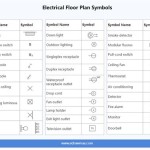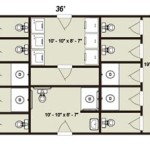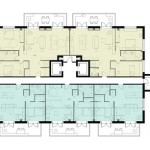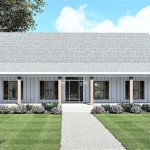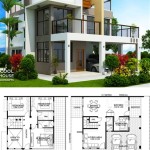Home Plans With RV Storage: Integrating Recreation and Residence
The increasing popularity of recreational vehicles (RVs) as a means of travel and recreation has led to a growing demand for home plans that incorporate dedicated RV storage. These designs cater to RV owners by providing secure, convenient, and often climate-controlled spaces to house their vehicles when not in use, eliminating the need for off-site storage facilities. Integrating RV storage into a home plan requires careful consideration of several factors, including lot size, architectural style, local building codes, and the owner's specific needs and preferences. This article explores the key aspects of home plans with RV storage, detailing the various design options, benefits, and considerations involved in creating a functional and aesthetically pleasing space for RV accommodation.
Home plans with RV storage represent a significant investment and should be carefully considered. The design process often begins with an assessment of the RV's dimensions, including length, width, and height. This information is crucial for determining the required size of the storage space. Additionally, consideration should be given to the turning radius needed to maneuver the RV in and out of the storage area. Lot size and shape play a crucial role in determining the feasibility of incorporating RV storage into a home design. Narrow lots or those with unusual configurations may present challenges that require creative solutions. Local building codes and zoning regulations must also be adhered to. These regulations often dictate allowable building heights, setbacks from property lines, and permissible uses for accessory structures.
Advantages of Incorporating RV Storage Into a Home Plan
One of the primary advantages of integrating RV storage into a home plan is the convenience it offers. RV owners can easily access their vehicles for maintenance, cleaning, and preparation for trips without the need to travel to an off-site storage facility. This accessibility saves time and reduces the hassle associated with retrieving and returning the RV. Secondly, on-site RV storage provides enhanced security. By keeping the RV on the property, owners can monitor its condition and deter potential theft or vandalism. This added security can provide peace of mind, especially during periods of extended storage. Finally, incorporating RV storage into a home plan can potentially increase the overall property value. Homes with dedicated RV storage are attractive to RV enthusiasts and may command a higher price in the real estate market.
Beyond these primary advantages, there are several other benefits to consider. On-site storage eliminates the monthly fees associated with off-site facilities, resulting in long-term cost savings. The saved money can then be allocated to RV maintenance or travel expenses. Furthermore, having the RV readily available encourages more frequent use. Spontaneous trips become easier to plan and execute when the RV is stored conveniently at home. Finally, integrating RV storage into a home design allows for greater control over the storage environment. Owners can ensure that the storage space is properly ventilated, temperature-controlled, and protected from the elements, which helps to preserve the RV's condition and prevent damage.
Design Options for RV Storage
Several design options are available for incorporating RV storage into a home plan, each with its own set of advantages and disadvantages. One common option is a detached garage or carport specifically designed to accommodate an RV. These structures can be customized to match the architectural style of the main house and can include features such as high ceilings, wide doors, and reinforced floors to support the weight of the RV. Detached structures offer flexibility in terms of placement on the property and can be designed to minimize visual impact on the surrounding landscape. Another option is an attached garage with RV storage. This design integrates the RV storage space directly into the main house, providing convenient access and often allowing for climate control and direct entry into the home. Attached garages require complex structural considerations to ensure proper support and load distribution. A third possibility is a covered RV pad. This option involves creating a designated parking area for the RV and covering it with a roof or canopy to protect it from the elements. Covered RV pads are less expensive than enclosed garages but offer limited protection from weather and potential theft.
When selecting a design option, it is important to consider the aesthetic impact on the overall property. A well-designed RV storage space should complement the architectural style of the main house and not detract from its curb appeal. The materials used for the storage structure should match or coordinate with those of the house, and landscaping can be used to soften the visual impact of the structure. For example, a detached garage can be designed with similar siding, roofing, and trim details as the house. Landscaping elements such as trees, shrubs, and vines can be used to screen the garage from view and integrate it into the surrounding landscape. Additionally, the positioning of the RV storage space should be carefully considered to minimize its visibility from the street and neighboring properties.
Key Considerations for Planning RV Storage
Planning for RV storage requires careful attention to several key considerations. One of the most important factors is the size of the RV. The storage space must be large enough to accommodate the RV comfortably, with sufficient clearance for maneuvering and maintenance. Experts recommend adding at least 2-3 feet of clearance on all sides of the RV to allow for easy access and prevent damage. The door height should be high enough to accommodate the RV's tallest point, including any roof-mounted accessories such as antennas or air conditioners. A further consideration is accessibility. The RV storage space should be located in an area that is easily accessible from the driveway or street, with a smooth and level surface for maneuvering the RV. The driveway should be wide enough to accommodate the RV's turning radius, and any obstacles such as trees or fences should be removed to ensure unobstructed access. Drainage is another important factor to consider, especially in areas with heavy rainfall. The RV storage space should be properly graded to prevent water from pooling around the RV, which can lead to rust and other damage. A drainage system, such as a French drain or a surface drain, may be necessary to ensure proper water runoff.
In addition to these factors, homeowners should also consider the need for electrical and plumbing hookups in the RV storage space. Electrical outlets can be used to power lights, tools, and other equipment, while plumbing hookups can be used to wash the RV or fill its water tank. Climate control may also be desirable, especially in areas with extreme temperatures. Insulating the RV storage space and installing a heating or cooling system can help to protect the RV from damage caused by temperature fluctuations. Security measures are another important consideration. The RV storage space should be equipped with a secure door or gate, and a security system with motion detectors and alarms can be installed to deter potential theft or vandalism. Lighting is also important for security, and motion-activated lights can be used to illuminate the area around the RV storage space at night. Finally, homeowners should consider the long-term maintenance requirements of the RV storage space. The structure should be designed to be durable and easy to maintain, and regular inspections should be conducted to identify and address any potential problems.
The integration of RV storage into a home plan is a multifaceted endeavor that requires careful planning and execution. By considering the various design options, weighing the advantages and disadvantages of each, and paying close attention to key considerations such as RV size, accessibility, drainage, and security, homeowners can create a functional and aesthetically pleasing space that meets their specific needs and enhances the value of their property.

Storage Solutions Rv Garage Plans And More Houseplans Blog Com

Storage Solutions Rv Garage Plans And More Houseplans Blog Com

12 Rv Casita Plans Ideas House Floor How To Plan Homes

Storage Solutions Rv Garage Plans And More Houseplans Blog Com

Rv Garage Home Floorplan We Love It House Plans Pole Barn Floor

Rv Garage Plans Apartment Plan With Attached Bay 006g 0160 At Thegarageplan Com

Rv Garage Plans With Incredible Storage Blog Dreamhomesource Com

Rv Garage Plans With Incredible Storage Blog Dreamhomesource Com

Rv Boat Storage Type Garage Plans

Plan 006g 0160 The House

